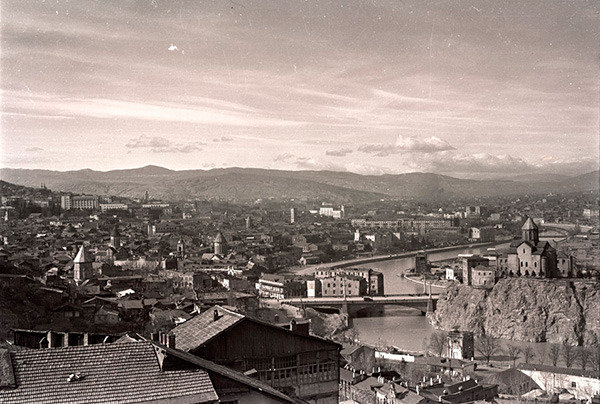To See the Dimensions
dal 1/9/2011 al 29/10/2011
Segnalato da
Thea Djordjadze
Mamuka Japharidze
David Kakabadze
Koka Ramishvili
Alexander Rekhviashvili
Wato Tsereteli
Guram Tsibakhashvili
1/9/2011
To See the Dimensions
Lunds Konsthall, Lund
An exhibition with artists from Georgia will inevitably have a political dimension. The artists selected are all from Georgia, that is the outer framework of the exhibition, but they are selected because their work seems to converge in a concern for the 'dimensionality' of art. Works by Thea Djordjadze, Mamuka Japharidze, David Kakabadze, Koka Ramishvili, Alexander Rekhviashvili, Wato Tsereteli, Guram Tsibakhashvili.

Thea Djordjadze, Mamuka Japharidze, David Kakabadze, Koka Ramishvili, Alexander Rekhviashvili, Wato Tsereteli, Guram Tsibakhashvili
An exhibition with artists from Georgia will inevitably have a political dimension. To a Western audience, Georgia is sufficiently unknown to provoke curiosity, but at the same time sufficiently known to be representable, imaginable. Georgia is associated with geopolitics on a grand scale: the Great Game that followed the collapse of the USSR twenty years ago. The short war between Georgia and Russia in August 2008 was just the best-publicised event in a continuous development that involves oil and hegemony, values and ambitions, Eurasia, the Middle East, the US and the EU. Yet an exhibition should not be a narrative that sticks to one topic, even if it is as complex as Georgia's recent history. An exhibition should always be multi-dimensional.
The word 'dimension' is to do with measuring. It is related to 'metre', 'moon' (the celestial body that helps us measure time) and 'month' (the time unit measured out by the moon). Yet it is not a precise technical term. Instead it is used metaphorically most of the time, as an image that creates new images. A dimension (for instance one of the three spatial dimensions of basic geometry or the forth one that creates space-time) is perhaps best described as a dynamic mental model that demonstrates various approaches to a general idea of measuring, which is intimately connected with seeing. The artists selected for To See the Dimensions are all from Georgia, that is the outer framework of the exhibition, but they are selected because their work seems to converge in a concern for the 'dimensionality' of art. This is the inner framework.
Thea Djordjadze (born in 1971, lives in Berlin) contributes the installation Explain Away ე.ი. (2009, the two letters from the Georgian alphabet translate as 'i.e.'; 'that is'). Her carefully plotted four-dimensionality brings together a spatial construction, tangible objects and their dissolution in dreamt time. Mamuka Japharidze (born in 1962, lives in Tbilisi and in England) urges us to experience 'additional dimensions', using easily decipherable visual tricks: the bicycle taxi converted into a mobile pinhole camera in Opti-Mystic Translookation (2003–) or the black-and-white chessboard pattern that both conceals and reveals a delicate image of a pair of eyes in Invisible (2006–). Koka Ramishvili (born in 1956, lives in Geneva) reworks a recent and troubling past into images with an inbuilt political dimension, in which the documentary is only an input value. He presents several audiovisual works, among them War from My Window (1991–1992), Change (2005) and Tender Transitory Transport (2008). The filmmaker Alexander Rekhviashvili (born in 1938, lives in Tbilisi) is represented by The Step (1986, 84'), a portrait of the claustrophobic late Soviet everyday where all dimensions seem to have contracted to one cluttered interior. Wato Tsereteli (born in 1975, lives in Tbilisi) researches and revives his maternal grandparent's documentation of Georgian architectural monuments. The images selected for The Archive (2011) tease out the photographers' subjectivity as a visible dimension of Romantic Modernism. Guram Tsibakhashvili (born in 1960, lives in Tbilisi) pairs snapshots of urban life twenty years ago with quotes from James Joyce in Ulysses (1989–1994), thereby contracting and displacing the dimensions of submerged time into images of a shared unconscious.
These contemporary artists operate within established visual regimes (sculpture, photography, moving image, performance) but also question them and shift their boundaries. This is also true of David Kakabadze (1889–1952), a key figure of Georgian art history: painter, sculptor, stage designer, photographer, filmmaker, pedagogue, art historian, inventor. He went to Paris in 1919, with a grant from the government of then-independent Georgia. After returning to Tbilisi in 1927 he held almost all important positions in the art life of Soviet Georgia, but he fell out with the authorities during the Second World War and ended his life as an outcast. We are focusing on Kakabadze's experiments with three-dimensionality. He invented a stereoscopic cinema system in 1923 and proposed a method for producing 'analogue holograms' in 1950, segmenting a photograph of Stalin's head into 19 'slices' to demonstrate his idea. In collaboration with the art historian and Kakabadze expert Ketevan Kintsurashvili, Lunds konsthall has now built a prototype of this device for the first time.
To See the Dimensions. Artists from Georgia is organised with generous support from the Swedish Institute. Warm thanks also to Center of Contemporary Art – Tbilisi for its logistical support, to Thea Djordjadze's gallery, Sprüth Magers Berlin London, for lending Explain Away ე.ი. and to M HKA in Antwerp for lending Koka Ramishvili's works.
Image: Wato Tsereteli: The Archive (2011). Tbilisi in the 1950s. Photograph by Vakhtang Tsinsadze (1915–1993).
Courtesy of the artist.
Opening Friday, 2 September 6–8pm
Lunds konsthall
Mårtenstorget 3
SE-223 51 Lund, Sweden
Opening hours
Tuesday, Wed, Fri, Sut noon – 5 pm
Thursday, noon – 8 pm, Saturday, 10 am – 5 pm
Free entrance



